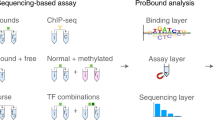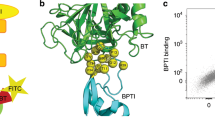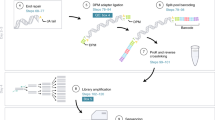Abstract
Several methods for characterizing DNA-protein interactions are available1,2,3,4,5,6, but none have demonstrated both high throughput and quantitative measurement of affinity. Here we describe 'high-throughput sequencing'-'fluorescent ligand interaction profiling' (HiTS-FLIP), a technique for measuring quantitative protein-DNA binding affinity at unprecedented depth. In this approach, the optics built into a high-throughput sequencer are used to visualize in vitro binding of a protein to sequenced DNA in a flow cell. Application of HiTS-FLIP to the protein Gcn4 (Gcn4p), the master regulator of the yeast amino acid starvation response7, yielded ∼440 million binding measurements, enabling determination of dissociation constants for all 12-mer sequences having submicromolar affinity. These data revealed a complex interdependency between motif positions, allowed improved discrimination of in vivo Gcn4p binding sites and regulatory targets relative to previous methods and showed that sets of genes with different promoter affinities to Gcn4p have distinct functions and expression kinetics. Broad application of this approach should increase understanding of the interactions that drive transcription.
This is a preview of subscription content, access via your institution
Access options
Subscribe to this journal
Receive 12 print issues and online access
$209.00 per year
only $17.42 per issue
Buy this article
- Purchase on Springer Link
- Instant access to full article PDF
Prices may be subject to local taxes which are calculated during checkout



Similar content being viewed by others
References
Klug, S.J. & Famulok, M. All you wanted to know about SELEX. Mol. Biol. Rep. 20, 97–107 (1994).
Ren, B. et al. Genome-wide location and function of DNA binding proteins. Science 290, 2306–2309 (2000).
Mukherjee, S. et al. Rapid analysis of the DNA-binding specificities of transcription factors with DNA microarrays. Nat. Genet. 36, 1331–1339 (2004).
Johnson, D.S., Mortazavi, A., Myers, R.M. & Wold, B. Genome-wide mapping of in vivo protein-DNA interactions. Science 316, 1497–1502 (2007).
Zhao, Y., Granas, D. & Stormo, G.D. Inferring binding energies from selected binding sites. PLOS Comput. Biol. 5, e1000590 (2009).
Fordyce, P.M. et al. De novo identification and biophysical characterization of transcription-factor binding sites with microfluidic affinity analysis. Nat. Biotechnol. 28, 970–975 (2010).
Natarajan, K. et al. Transcriptional profiling shows that Gcn4p is a master regulator of gene expression during amino acid starvation in yeast. Mol. Cell. Biol. 21, 4347–4368 (2001).
Noyes, M.B. et al. Analysis of homeodomain specificities allows the family-wide prediction of preferred recognition sites. Cell 133, 1277–1289 (2008).
Badis, G. et al. Diversity and complexity in DNA recognition by transcription factors. Science 324, 1720–1723 (2009).
Zhu, C. et al. High-resolution DNA-binding specificity analysis of yeast transcription factors. Genome Res. 19, 556–566 (2009).
Gottardo, R. Modeling and analysis of ChIP-chip experiments. Methods Mol. Biol. 567, 133–143 (2009).
Bentley, D.R. et al. Accurate whole human genome sequencing using reversible terminator chemistry. Nature 456, 53–59 (2008).
Harbison, C.T. et al. Transcriptional regulatory code of a eukaryotic genome. Nature 431, 99–104 (2004).
Chua, G. et al. Identifying transcription factor functions and targets by phenotypic activation. Proc. Natl. Acad. Sci. USA 103, 12045–12050 (2006).
Wang, H., Johnston, M. & Mitra, R.D. Calling cards for DNA-binding proteins. Genome Res. 17, 1202–1209 (2007).
Shi, Y., Klutstein, M., Simon, I., Mitchell, T. & Bar-Joseph, Z. A combined expression-interaction model for inferring the temporal activity of transcription factors. J. Comput. Biol. 16, 1035–1049 (2009).
Herzog, B., Streckfuss-Bomeke, K. & Braus, G.H. A feedback circuit between transcriptional activation and self-destruction of Gcn4 separates its metabolic and morphogenic response in diploid yeasts. J. Mol. Biol. 405, 909–925 (2011).
Hope, I.A. & Struhl, K. Functional dissection of a eukaryotic transcriptional activator protein, GCN4 of yeast. Cell 46, 885–894 (1986).
Oliphant, A.R., Brandl, C.J. & Struhl, K. Defining the sequence specificity of DNA-binding proteins by selecting binding sites from random-sequence oligonucleotides: analysis of yeast GCN4 protein. Mol. Cell. Biol. 9, 2944–2949 (1989).
Jorgensen, P. et al. The size of the nucleus increases as yeast cells grow. Mol. Biol. Cell 18, 3523–3532 (2007).
Hill, D.E., Hope, I.A., Macke, J.P. & Struhl, K. Saturation mutagenesis of the yeast his3 regulatory site: requirements for transcriptional induction and for binding by GCN4 activator protein. Science 234, 451–457 (1986).
Sellers, J.W., Vincent, A.C. & Struhl, K. Mutations that define the optimal half-site for binding yeast GCN4 activator protein and identify an ATF/CREB-like repressor that recognizes similar DNA sites. Mol. Cell. Biol. 10, 5077–5086 (1990).
Hollenbeck, J.J. & Oakley, M.G. GCN4 binds with high affinity to DNA sequences containing a single consensus half-site. Biochemistry 39, 6380–6389 (2000).
Cranz, S., Berger, C., Baici, A., Jelesarov, I. & Bosshard, H.R. Monomeric and dimeric bZIP transcription factor GCN4 bind at the same rate to their target DNA site. Biochemistry 43, 718–727 (2004).
Man, T.K. & Stormo, G.D. Non-independence of Mnt repressor-operator interaction determined by a new quantitative multiple fluorescence relative affinity (QuMFRA) assay. Nucleic Acids Res. 29, 2471–2478 (2001).
Bulyk, M.L. Analysis of sequence specificities of DNA-binding proteins with protein binding microarrays. Methods Enzymol. 410, 279–299 (2006).
Tanay, A. Extensive low-affinity transcriptional interactions in the yeast genome. Genome Res. 16, 962–972 (2006).
Prill, R.J. et al. Towards a rigorous assessment of systems biology models: the DREAM3 challenges. PLoS ONE 5, e9202 (2010).
Gertz, J., Siggia, E.D. & Cohen, B.A. Analysis of combinatorial cis-regulation in synthetic and genomic promoters. Nature 457, 215–218 (2009).
Gaudet, J. & Mango, S.E. Regulation of organogenesis by the Caenorhabditis elegans FoxA protein PHA-4. Science 295, 821–825 (2002).
Cranz, S., Berger, C., Baici, A., Jelesarov, I. & Bosshard, H.R. Monomeric and dimeric bZIP transcription factor GCN4 bind at the same rate to their target DNA site. Biochemistry 43, 718–727 (2004).
Hellman, L.M. & Fried, M.G. Electrophoretic mobility shift assay (EMSA) for detecting protein-nucleic acid interactions. Nat. Protoc. 2, 1849–1861 (2007).
Acknowledgements
The authors thank G. Braus for providing the GCN4 containing plasmids, N. Clarke for sharing amino acid starvation microarray time course data, A. Keating and A. Reinke for advice on EMSA experiments, T. Theara, S. Levine and the Biomicro Center at Massachusetts Institute of Technology for help with Illumina sequencing technology and initial experiments, and L. Boyer, N. Clarke, W. Gilbert, P. Sharp and members of the Burge laboratory for helpful discussion and comments on the manuscript. This work was supported by a Human Frontiers Science Program long-term fellowship (R.N.), a Computational Science Graduate Fellowship from the Office of Science in the Department of Energy under contract DE-FG02-97ER25308 (R.C.F.), by a major equipment grant from the National Science Foundation (no. 0821391) and by grants from the US National Institutes of Health (C.B.B.).
Author information
Authors and Affiliations
Contributions
R.N., initial idea, experimental design and initial implementation, Gcn4p purification and EMSA experiments; R.C.F., experimental design and initial implementation, computational analysis of image data, all bioinformatic analyses; S.L. and G.P.S., experimental design and method optimization; I.K., D.S., R.L., L.Z., method optimization; C.B.B., initial idea, coordination of project, contributions to bioinformatics analyses.
Corresponding author
Ethics declarations
Competing interests
S.L., I.K., D.S., R.L., L.Z. and G.P.S. are employees of Illumina.
Supplementary information
Supplementary Text and Figures
Supplementary Tables 6, 8, Supplementary Methods, Discussion and Supplementary Figures 1–11 (PDF 1463 kb)
Supplementary Table 1
HiTS-FLIP dissociation constants for 8mers. (TXT 9 kb)
Supplementary Table 2
HiTS-FLIP dissociation constants for 9mers. (TXT 48 kb)
Supplementary Table 3
HiTS-FLIP dissociation constants for 10mers. (TXT 203 kb)
Supplementary Table 4
HiTS-FLIP dissociation constants for 11mers. (TXT 881 kb)
Supplementary Table 5
HiTS-FLIP dissociation constants for 12mers. (TXT 3887 kb)
Supplementary Table 7
Predicted promoter occupancies using 8mer Kd values or PBM data. (TXT 235 kb)
Rights and permissions
About this article
Cite this article
Nutiu, R., Friedman, R., Luo, S. et al. Direct measurement of DNA affinity landscapes on a high-throughput sequencing instrument. Nat Biotechnol 29, 659–664 (2011). https://doi.org/10.1038/nbt.1882
Received:
Accepted:
Published:
Issue Date:
DOI: https://doi.org/10.1038/nbt.1882
This article is cited by
-
Rapid discovery of high-affinity antibodies via massively parallel sequencing, ribosome display and affinity screening
Nature Biomedical Engineering (2023)
-
Human DNA/RNA motif mining using deep-learning methods: a scoping review
Network Modeling Analysis in Health Informatics and Bioinformatics (2023)
-
Navigating the pitfalls of applying machine learning in genomics
Nature Reviews Genetics (2022)
-
An open source toolkit for repurposing Illumina sequencing systems as versatile fluidics and imaging platforms
Scientific Reports (2022)
-
Development of a sequencing system for spatial decoding of DNA barcode molecules at single-molecule resolution
Communications Biology (2020)



